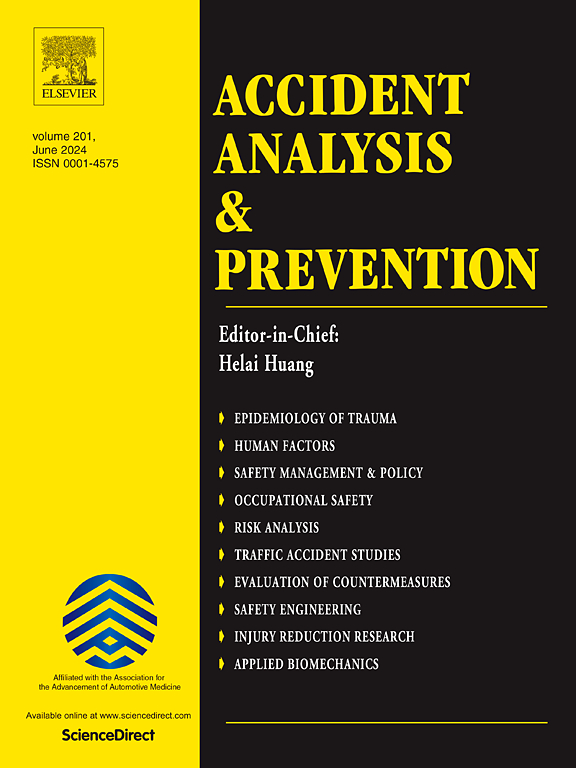自动驾驶汽车碰撞模式的异质性:潜类分析与多叉 Logit 模型相结合。
IF 5.7
1区 工程技术
Q1 ERGONOMICS
引用次数: 0
摘要
了解自动驾驶汽车(AV)碰撞模式的异质性对于提高自动驾驶交通系统的安全性和公众接受度至关重要。本文首先从加利福尼亚州机动车辆管理局(CA DMV)的 584 份自动驾驶汽车碰撞报告中提取了变量,并通过高度自动和快速的变量提取框架进行了扩充。碰撞损坏严重程度分为无、轻微、中等和严重,被设定为因变量。包括碰撞、道路、时间、车辆和环境特征在内的因素被确定为潜在的决定因素。为了考虑碰撞数据固有的异质性,并确定影响反车辆碰撞损害严重程度的关键因素,采用了潜类分析和多叉 Logit 模型相结合的方法。根据车辆状态和驾驶模式的倾斜分布,确定了两个异质性群组。模型估计结果表明,严重碰撞损害与一些风险因素(如迎面、交叉路口、多车、有路灯的黑暗环境、无路灯的黑暗环境和清晨)之间存在正相关。这项研究还揭示了影响两个不同子类损坏严重程度的变量之间的显著差异。此外,将反车辆碰撞数据集划分为不同的子集,有助于识别在对数据集进行整体分析时仍然模糊不清的关键因素,例如傍晚指标。本文不仅加深了我们对反车辆碰撞模式的理解,还为更安全的反车辆技术铺平了道路。本文章由计算机程序翻译,如有差异,请以英文原文为准。
Heterogeneity in crash patterns of autonomous vehicles: The latent class analysis coupled with multinomial logit model
Understanding the heterogeneity in autonomous vehicle (AV) crash patterns is crucial for enhancing the safety and public acceptance of autonomous transportation systems. In this paper, 584 AV collision reports from the California Department of Motor Vehicles (CA DMV) were first extracted and augmented by a highly automatic and fast variable extraction framework. Crash damage severities, classified as none, minor, moderate, and major, were set as the dependent variables. Factors including crash, road, temporal, vehicle, and environment characteristics were identified as potential determinants. To account for the heterogeneity inherent in crash data and identify key factors influencing the damage severity in AV crashes, a methodology integrating the latent class analysis and multinomial logit model was employed. Two heterogeneous clusters were determined based on the skewed distributions of vehicle status and driving mode. The model estimation results indicate a positive association between severe crash damage and some risk factors, such as head-on, intersection, multiple vehicles, dark with street lights, dark without street lights, and early morning. This study also reveals significant differences among the variables influencing the damage severity across two distinct subclasses. Moreover, partitioning the AV crash dataset into heterogeneous subsets facilitates the identification of critical factors that remain obscured when the dataset is analyzed as a whole, such as the evening indicator. This paper not only enhances our understanding of AV crash patterns but also paves the way for safer AV technology.
求助全文
通过发布文献求助,成功后即可免费获取论文全文。
去求助
来源期刊

Accident; analysis and prevention
Multiple-
CiteScore
11.90
自引率
16.90%
发文量
264
审稿时长
48 days
期刊介绍:
Accident Analysis & Prevention provides wide coverage of the general areas relating to accidental injury and damage, including the pre-injury and immediate post-injury phases. Published papers deal with medical, legal, economic, educational, behavioral, theoretical or empirical aspects of transportation accidents, as well as with accidents at other sites. Selected topics within the scope of the Journal may include: studies of human, environmental and vehicular factors influencing the occurrence, type and severity of accidents and injury; the design, implementation and evaluation of countermeasures; biomechanics of impact and human tolerance limits to injury; modelling and statistical analysis of accident data; policy, planning and decision-making in safety.
 求助内容:
求助内容: 应助结果提醒方式:
应助结果提醒方式:


